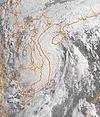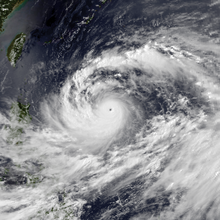Portal:Tropical cyclones
The Tropical Cyclones Portal

A tropical cyclone is a storm system characterized by a large low-pressure center, a closed low-level circulation and a spiral arrangement of numerous thunderstorms that produce strong winds and heavy rainfall. Tropical cyclones feed on the heat released when moist air rises, resulting in condensation of water vapor contained in the moist air. They are fueled by a different heat mechanism than other cyclonic windstorms such as Nor'easters, European windstorms and polar lows, leading to their classification as "warm core" storm systems. Most tropical cyclones originate in the doldrums, approximately ten degrees from the Equator.
The term "tropical" refers to both the geographic origin of these systems, which form almost exclusively in tropical regions of the globe, as well as to their formation in maritime tropical air masses. The term "cyclone" refers to such storms' cyclonic nature, with anticlockwise rotation in the Northern Hemisphere and clockwise rotation in the Southern Hemisphere. Depending on its location and intensity, a tropical cyclone may be referred to by names such as "hurricane", "typhoon", "tropical storm", "cyclonic storm", "tropical depression" or simply "cyclone".
Types of cyclone: 1. A "Typhoon" is a tropical cyclone located in the North-west Pacific Ocean which has the most cyclonic activity and storms occur year-round. 2. A "Hurricane" is also a tropical cyclone located at the North Atlantic Ocean or North-east Pacific Ocean which have an average storm activity and storms typically form between May 15 and November 30. 3. A "Cyclone" is a tropical cyclone that occurs in the South Pacific and Indian Oceans.
Selected named cyclone -
Typhoon Thelma, known in the Philippines as Typhoon Katring, was the first super typhoon to form in the 1987 Pacific typhoon season. Forming from the monsoon trough in the Philippine Sea, Thelma was first designated as a tropical cyclone on July 7. After moving north, Thelma turned west, while remaining poorly organized. It finally attained typhoon status on July 9, soon after developing an eye, and began to intensify at a brisker clip. During the evening of July 10, Thelma attained maximum intensity while well to the east of the northern Philippines. It also turned sharply northward in response to a trough, slowly weakening. On July 15, Typhoon Thelma, now greatly reduced in intensity, struck the south coast of South Korea. The next day, Thelma rapidly dissipated, shortly after emerging into the Sea of Japan.
Although Thelma remained well offshore the Philippines, around 500 homes were swept away due to flooding, which left more than 3,500 people homeless. A total of 130 people were rescued after a vessel sunk. Nationwide, 12 people perished. In Japan, the typhoon brought heavy rains that was responsible for property damage in 19 prefectures. Throughout the country, three people died while around 1,000 dwellings were flooded. (Full article...)Selected article -
The 1903 New Jersey hurricane, also known as the Vagabond Hurricane by The Press of Atlantic City, is the first and only known North Atlantic hurricane to make landfall in the state of New Jersey since records were kept starting in 1851. The fourth hurricane of the season, the cyclone was first observed on September 12 about 550 miles (890 kilometres) northeast of Antigua. It moved quickly westward, then later turned to the north-northwest, steadily strengthening to reach a peak intensity of 100 miles per hour (155 kilometres per hour), a Category 2 on the modern-day Saffir–Simpson scale. The hurricane weakened slightly before striking near Atlantic City, New Jersey, on September 16 with winds of 80 mph (130 km/h). It weakened over Pennsylvania and became an extratropical cyclone over western New York on September 17.
Rough surf and moderate winds from the hurricane capsized several ships along the East Coast of the United States; 30 people were left missing and presumed killed from a shipwreck in Chincoteague, Virginia. Along the coast, 57 people died due to the storm. In New Jersey, the hurricane caused heavy damage, particularly near the coast and in Atlantic City. Dozens of buildings were damaged or destroyed, and damage across the state totaled $8 million (1903 USD). In New York City, high winds disrupted traffic, closed businesses, and overturned wagons, with many windows and roofs damaged. On Long Island, President Theodore Roosevelt directly experienced the effects of the hurricane while on a yacht. The life of the president was briefly threatened by the rough conditions, though none on board the yacht suffered any problems from the hurricane. (Full article...)Selected image -

Selected season -

The 2018 Pacific hurricane season was one of the most active Pacific hurricane seasons on record, producing the highest accumulated cyclone energy value on record in the basin. The season had the fourth-highest number of named storms – 23, tied with 1982. The season also featured eight landfalls, six of which occurred in Mexico. The season officially began on May 15 in the Eastern Pacific, and on June 1 in the Central Pacific; they both ended on November 30. These dates conventionally delimit the period of each year when most tropical cyclones form in the Pacific basin. However, tropical cyclone formation is possible at any time of the year, as illustrated when the first tropical depression formed on May 10, five days prior to the official start of the season.
The second named storm of the season, Hurricane Bud, struck Baja California Sur in mid-June, causing minor damage. Tropical Storm Carlotta stalled offshore of the Mexican coastline, where it also caused minor damage. In early August, Hurricane Hector became one of the few tropical cyclones to cross into the Western Pacific from the Eastern Pacific, while also affecting Hawaii. Tropical Storm Ileana brought torrential rainfall to southwestern Mexico during early August, causing relatively minor damage. A few weeks later, Hurricane Lane obtained Category 5 intensity while also becoming Hawaii's wettest tropical cyclone on record and the second wettest tropical cyclone in United States history, only behind Hurricane Harvey of the previous year. Hurricane Olivia also struck Hawaii, resulting in relatively minor damage. (Full article...)Related portals
Currently active tropical cyclones

Italicized basins are unofficial.
- North Atlantic (2024)
- No active systems
- East and Central Pacific (2024)
- No active systems
- North Indian Ocean (2024)
- No active systems
- Mediterranean (2023–24)
- No active systems
- South-West Indian Ocean (2023–24)
- No active systems
- Australian region (2023–24)
- No active systems
- South Pacific (2023–24)
- No active systems
- South Atlantic (2023–24)
- No active systems
Last updated: 00:02, 23 May 2024 (UTC)
Tropical cyclone anniversaries

- May 22, 1996 - Tropical Storm Cam (pictured) reached its peak intensity with 110 km/h (70 mph) while moving to the east through the Luzon Strait between the Philippines and Taiwan.

May 23
- 1976 - Subtropical Storm One struck the Florida Panhandle, bringing heavy rainfall to the southeastern United States but only minimal damage.
- 2003 - Typhoon Chan-hom (pictured) reaches its maximum intensity as a Category 4 typhoon with a pressure of 940 mbar (27.76 inHg).

- May 24, 1989 - Tropical Storm Cecil (pictured) made landfall in central Vietnam where it killed 52 people and left over 100,000 others homeless.
Did you know…




- …that the Joint Typhoon Warning Center considers that Typhoon Vera (pictured) of 1986 is actually two distinct systems, formed from two separated low-level circulations?
- …that Hurricane Agatha (pictured) was the strongest Pacific hurricane to make landfall in Mexico in May since records began in 1949?
- …that Cyclone Raquel (track pictured) travelled between the Australian and South Pacific basins between the 2014–15 and 2015–16 seasons, spanning both seasons in both basins?
- …that Cyclone Amphan (pictured) in 2020 was the first storm to be classified as a Super Cyclonic Storm in the Bay of Bengal since 1999?
General images -

The list of Florida hurricanes from 1900 to 1949 encompasses 108 Atlantic tropical cyclones that affected the U.S. state of Florida. Collectively, tropical cyclones in Florida during the time period resulted in about $4 billion (2008 USD) in damage. Additionally, tropical cyclones in Florida were directly responsible for about 3,550 fatalities during the time period, most of which from the 1928 Okeechobee Hurricane. The 1947 season was the year with the most tropical cyclones affecting the state, with a total of 6 systems. The 1905, 1908, 1913, 1927, 1931, 1942, and 1943 seasons were the only years during the time period in which a storm did not affect the Floridan coasts.
The strongest hurricane to hit the state during the time period was the 1935 Labor Day hurricane, which also bears the distinction of being the strongest recorded hurricane to strike the United States. Several other major hurricanes struck the state during the time period, including the 1926 Miami hurricane, the 1928 Okeechobee hurricane, and a cyclone each in 1945, 1947, 1948, and 1949. All of these storms made landfall as Category 4 hurricanes. (Full article...)Topics
Subcategories
Related WikiProjects
WikiProject Tropical cyclones is the central point of coordination for Wikipedia's coverage of tropical cyclones. Feel free to help!
WikiProject Weather is the main center point of coordination for Wikipedia's coverage of meteorology in general, and the parent project of WikiProject Tropical cyclones. Three other branches of WikiProject Weather in particular share significant overlaps with WikiProject Tropical cyclones:
- The Non-tropical storms task force coordinates most of Wikipedia's coverage on extratropical cyclones, which tropical cyclones often transition into near the end of their lifespan.
- The Floods task force takes on the scope of flooding events all over the world, with rainfall from tropical cyclones a significant factor in many of them.
- WikiProject Severe weather documents the effects of extreme weather such as tornadoes, which landfalling tropical cyclones can produce.
Things you can do
 |
Here are some tasks awaiting attention:
|
Wikimedia
The following Wikimedia Foundation sister projects provide more on this subject:
-
Commons
Free media repository -
Wikibooks
Free textbooks and manuals -
Wikidata
Free knowledge base -
Wikinews
Free-content news -
Wikiquote
Collection of quotations -
Wikisource
Free-content library -
Wikiversity
Free learning tools -
Wikivoyage
Free travel guide -
Wiktionary
Dictionary and thesaurus
























































